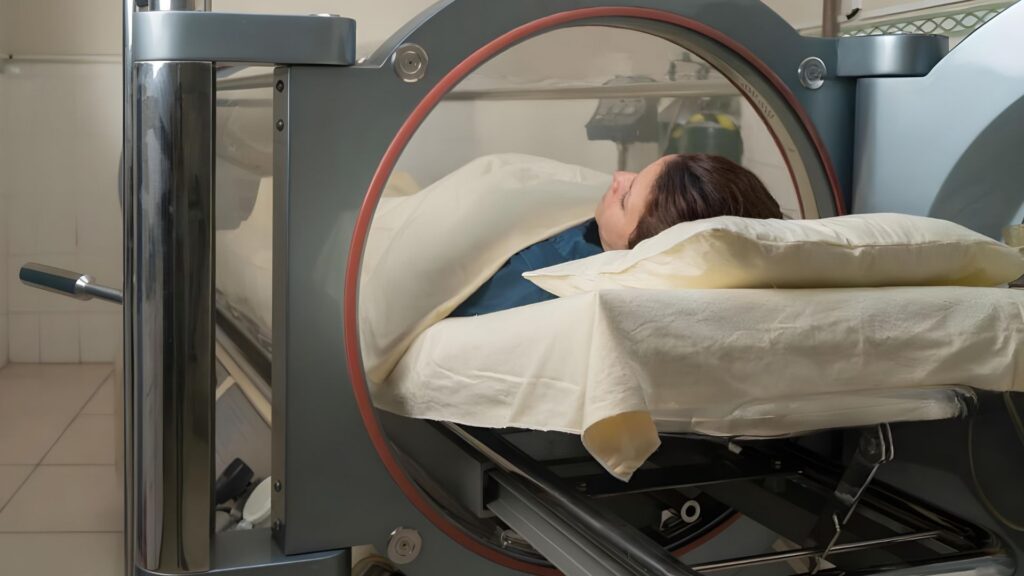Asthma affects over 25 million people in the United States alone, making it one of the most common chronic respiratory conditions. Managing asthma means controlling airway inflammation, reducing asthma symptoms, and preventing asthma flare-ups that can severely impact quality of life. This has led researchers and clinicians to explore hyperbaric oxygen therapy (HBOT) as a complementary approach to asthma management.
In this article, we will explore how hyperbaric oxygen therapy works, its potential benefits for asthma patients, and the role of HBOT in improving asthma symptoms and overall health.

What Is Hyperbaric Oxygen Therapy?
Hyperbaric oxygen therapy involves breathing pure oxygen in a pressurized chamber, often called a hyperbaric chamber. This therapy increases the amount of oxygen your blood can carry by exposing you to oxygen at pressure levels higher than normal atmospheric pressure. A multiplace chamber can accommodate several patients at once, while monoplace chambers are designed for single individuals.
By breathing pure oxygen in a pressurized chamber, the body takes in much more oxygen than it would under normal conditions. This extra oxygen helps improve oxygen delivery to tissues and organs, including the lungs, which is crucial for people with asthma who often struggle with reduced oxygen supply during asthma attacks.
Individuals living with asthma who are interested in the benefits of HBOT should consult a medical professional or a specialized hyperbaric oxygen therapy center to discuss treatment options tailored to their needs.
How Asthma Affects Oxygen Delivery
Asthma is closely linked to airway inflammation and constriction, which makes it harder for oxygen to reach your lungs and subsequently enter your bloodstream. When someone has asthma, their airways can swell and produce excess mucus, narrowing the passageways and triggering asthma symptoms like wheezing, coughing, and shortness of breath.
These reactions can trigger asthma attacks, during which oxygen levels in the body may drop dangerously low. Chronic asthma can cause long-term damage to lung tissue, further impairing oxygen delivery and making it harder for the body to get enough oxygen. This oxygen deficiency can leave asthma sufferers feeling fatigued, anxious, and short of breath, especially during flare-ups.
The Role of Hyperbaric Oxygen Therapy in Asthma Management
The use of hyperbaric oxygen therapy for asthma is not a cure for asthma, but it could offer significant benefits as part of a comprehensive asthma treatment plan. The effects of hyperbaric oxygen therapy include:
Increased Oxygen Levels
HBOT increases oxygen levels in the blood by allowing patients to breathe in pure oxygen in a pressurized chamber. This means there is more oxygen in the blood, allowing more oxygen to reach the lungs and tissues, helping to overcome the oxygen deficit caused by airway constriction.
Reduced Inflammation
The therapy has been shown to reduce inflammation in the body, which is a key factor in asthma. By calming airway swelling, hyperbaric oxygen therapy could help reduce the severity and frequency of asthma flare-ups.
Improved Immune Response
HBOT may help regulate immune system reactions that can trigger asthma attacks, potentially improving overall asthma control.
Enhanced Healing
The therapy promotes tissue repair and reduces oxidative stress, which may help heal lung tissue damaged by chronic asthma.

Evidence Supporting HBOT for Asthma Patients
While more large-scale clinical trials are needed, preliminary studies and patient reports suggest that hyperbaric oxygen treatment can improve asthma symptoms and reduce the number of asthma attacks in some patients. The benefits of HBOT for asthma patients include better oxygen supply during asthma attacks, decreased airway inflammation, and improved lung function.
Asthma management by reducing airway inflammation and improving oxygen delivery can help many people with asthma experience better asthma control and a higher quality of life.
Safety and Considerations
Hyperbaric oxygen therapy must be administered under medical supervision because it involves breathing pure oxygen at pressure, which carries risks such as oxygen toxicity if not properly managed. Hyperbaric contraindications include certain lung diseases, untreated pneumothorax, and some types of ear or sinus problems.
Before starting HBOT for asthma, it is essential to consult with a healthcare provider or a hyperbaric healing treatment center to determine if this therapy is appropriate and safe for your specific condition.
Integrating HBOT Into Your Asthma Treatment Plan
HBOT is best used as a complementary therapy alongside traditional asthma treatments rather than a replacement. Managing your asthma effectively means combining medications, lifestyle changes, trigger avoidance, and possibly adjunct therapies like hyperbaric oxygen therapy.
A typical hyperbaric oxygen treatment session involves spending time in a pressurized chamber, breathing pure oxygen for a prescribed period. Treatment protocols vary depending on the severity of asthma and individual patient needs.
Final Thoughts from Quantum Wellness Center
For asthma patients seeking better asthma control and improved overall health, exploring how hyperbaric oxygen therapy could fit into their treatment plan is worthwhile.
At Quantum Wellness Center in Sarasota, Florida, we offer advanced hyperbaric oxygen therapy customized to support your asthma management needs. Our goal is to help you enhance oxygen delivery, reduce airway inflammation, and improve your overall respiratory health. Experience the benefits of HBOT for asthma patients with us and take the first step toward better breathing and improved quality of life today.



